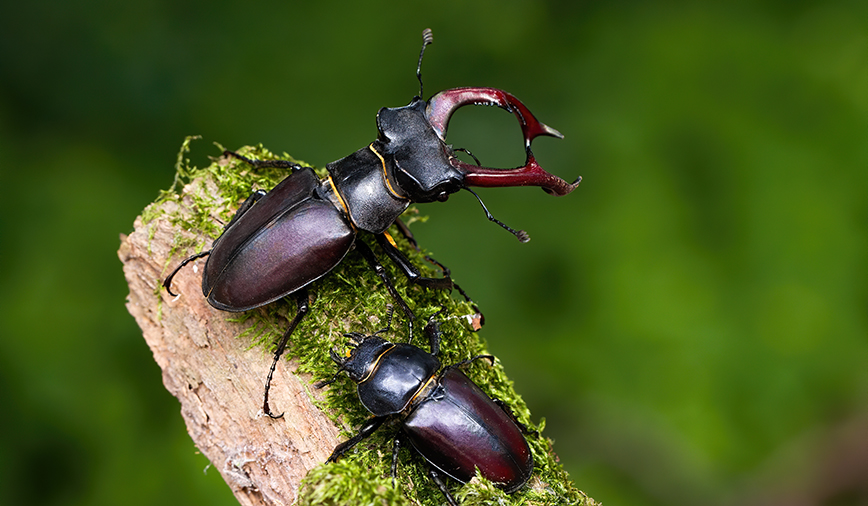Pam’s Perspective
From the…
Pam Otto is the Manager of Natural Programs and
Interpretive Services for the St. Charles Park District
July 19, 2012
The heady aroma of fine cigars. The rise and fall of male voices, punctuated with deep, booming
laughter. It didn’t take a girl popping out of a cake to tell us, a stag party was underway in the pavilion of
the Hickory Knolls Natural Area.
Meanwhile, a stone’s throw away at the Discovery Center, another gathering of stags was in full swing:
the Lucanidae, or stag beetles, had come out to play.
Stag beetles are the sorts of insects that are hard to miss. For one thing, their chunky bodies are an inch
or more in length—pretty big, by temperate climate standards. For another, the males have prominent
mandibles, branched structures that resemble deer antlers; hence the “stag” part of their name.
These large jaws also are responsible for the critter’s other common name, “pinching bug,” even though
their large size renders them pretty ineffective at anything other than wrestling with other males.
(Interestingly, the females’ smaller but considerably stronger mouthparts can pinch like the dickens.)
The species we have in our area belong to the genus Lucanus, a name that can be traced back to the
ancient Italian region of Lucania. Lucanians, the story goes, used stag beetles as amulets, and the name
stuck. Species names, like capreolus, our area’s most common stag, are from Greek words for various
types of deer and elk.
Indeed, with roles in courtship battles as well as displays to
prospective mates, the antler-like mandibles are a big part
of the adult stag beetles’ life. But, as is the case with most
insects, the adult chapter of the beetles’ life actually is a
very small part of a much bigger story.
Stag beetles spend the majority of their lives in an
immature, or larval, stage–two years, for the stags in our
area, and four to six years for species in other parts of the world– a stark contrast to the month or two
that adults may survive.
Stag beetle larvae, known as grubs, live out their days in rotting wood, chewing and digesting (with the
aid of special bacteria in their hind gut) cellulose and helping advance a fallen tree’s decomposition.
(Note: Stag beetle larvae are large—about the size of a child’s thumb–and do not eat living plant
material. If you’re finding small grubs in your lawn, they likely are the larvae of a much less welcome
species, the Japanese beetle.)
That stag beetle larvae have an important job is pretty cool. But wait, there’s more: Stag beetle larvae
apparently “talk” while they’re eating.
Now, as humans, we’ve probably experienced this phenomenon more times than any of us care to
remember. The garrulous relative you were paired with at wedding reception; that obnoxious person
your colleagues ditched on you at a business function…we’ve all been there.
But stag beetles, believe it or not, are way neater. Far from spewing crumbs while their mouths are full,
the larvae instead use a means of communication known as stridulation—rubbing one body part against
another to make sound.
Crickets rubbing wings together to produce their characteristic chirps is perhaps the best-known form of
stridulation; grasshoppers rubbing legs against wings is probably a close second.
On stag beetle larvae, the sound is produced when claws on the hind legs are rubbed against ridges on
the middle pair of legs. Why these larvae stridulate is unclear, but the action surely has a purpose;
many other beetle larvae are known to make sounds too. Perhaps the vibrations help the larva lay claim
to a territory. There’s even speculation that the communication may be inter-specific.
Regardless of purpose, it’s just one more example of the vast network of unknowns lying at, and just
beneath, our feet.
Worldwide, stag beetles are facing a bit of a crisis; many European countries now include them on lists
of protected species. Land-management practices that favor the removal of dead wood have taken away
the habitat these beetles need to survive. Without them, or specifically their larva, essential cycling of
nutrients that needs to occur in order for soil to remain fertile comes to a grinding halt.
If you’re a gardener, or know someone who is, you can help conserve this helpful species by promoting
the use of stag beetle-friendly landscaping practices: Leave tree stumps and logs to decay naturally;
avoid the use of landscape cloth, which can trap newly transformed adult beetles and block their
emergence from the soil; and minimize the use of insecticides.
Even if everyone around you is getting rid of dead wood and spraying pesticide like there’s no
tomorrow, you have an opportunity to buck the trend and branch off on your own.
There’s no harm in going stag!
C:\Users\selm\Desktop\P1030492.JPG

